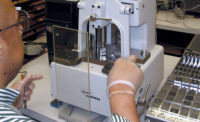People who work in manufacturing or quality control roles must ensure that produced goods meet a client’s exact specifications. One of the ways to do that is through a first article inspection (FAI).
What Is a First Article Inspection?
A first article inspection occurs when an authorized person — typically the supplier or a second-party inspector with a laboratory and specialized measuring equipment — takes one or several parts from the first production run. They then compare them to the client specifications to verify they match exactly. The purchase order contains that data, so it is the main reference point during the inspection.
Contrary to what some people assume, an FAI does not necessarily entail checking the first parts off the production line. It involves taking them from within that initial batch, although the people conducting the FAI often select them randomly.
What Happens if a Component Passes or Fails the FAI?
This inspection confirms that everything meets expectations before the production run continues. Operations pause until someone checks the part according to a well-defined framework. Provided that a part passes the FAI, the manufacturing of it resumes.
If a component fails, production ceases until the responsible parties find the cause and address it. After those things happen, another FAI occurs to assess whether production can resume. Performing that check is exceptionally important in certain industries that require precisely made parts for critical applications, such as those related to defense, aerospace and medical devices.
Some of those sectors have specific FAI requirements to follow. For example, the 9102 FAI aligns with the AS9102B, or the Aerospace First Article Inspection Requirement — a standard associated with SAE International. It shows objective evidence of the supplier’s ability to consistently uphold quality requirements. Moreover, it generates a document that a client can use to maintain accountability throughout the business relationship.
When Should a First Article Inspection Occur?
Besides carrying out an FAI during the first production run or when a part’s design changes, several other scenarios exist that make it appropriate to do one. For example, when a production lapse of two years or more happens, a first article inspection should be part of the process for restarting manufacturing.
Additionally, if any alterations occur in the materials, sourcing, process, tools or location, there should be accompanying first article inspections. Those checks show that the changes did not cause adverse consequences for a product’s functionality, dimensions or quality.
A delta FAI — also known as a partial FAI — occurs when a part or product goes through design changes. The report created in this instance breaks down the differences between the latest version and the original FAI.
What Should an Inspection Plan Include?
The first step of conducting an FAI involves creating an inspection plan. People start by adding balloons containing unique numbers to a drawing of the part. They tell inspectors what to check when scrutinizing that component. People can add the balloons to a picture by hand or using software to make the job easier.
The inspection plan should also have a table of the requirements for inspection. It should feature balloon numbers, associated specifications and relevant tolerances. This table is an essential part of the resulting document called the first article inspection report (FAIR). It gives a summary of whether a part passed or failed examination from a quality control inspector.
What Happens During an FAI?
A person performing a first article inspection has a document — often a checklist — that they refer to during their process to maintain thoroughness. That individual also uses specialized tools called coordinate measuring machines (CMMs) to compare the produced parts with their specifications. The goal is to see if they differ. If differences exist, they’ll check whether the variations come within the client’s tolerances.
CMMs are the most precise kinds of measuring tools available for quality control inspections. However, there are several types within that product category. For example, fixed CMMs are the most popular option among quality control managers. They can measure any product feature and work well for complex parts. There are also portable CMMs, suitable for components that are too large or cumbersome to move from the production floor.
The party responsible for doing the FAI uses their measuring tools to screen for issues that make the components fall short of the specifications. Some of the most common problems identified during the first article inspection include the wrong materials used, insufficient quality of the materials and incorrectly set processing equipment.
When Might a Client Deem a First Article Inspection Unnecessary?
An FAI offers numerous benefits, including waste reduction and time saved by catching problems sooner. However, there are some instances where a client may decide it is unnecessary or inappropriate to perform one. For example, perhaps the production batch is small, and the manufacturer is well accustomed to making the parts.
Alternatively, if a company has chosen a supplier to handle a large batch of a newly produced product, it may make more sense to do a pilot run in that instance. This requires a supplier to assume responsibility for a batch ranging from tens of products to hundreds and produce each one to the exact specifications the client needs. This approach means the supplier must demonstrate competency in a different way than passing a first article inspection.
A Crucial Part of the Quality Control Process
The first article inspection is certainly not the only type of test to perform when gauging quality. However, it can be a vital one during the production of some components. If a client wants to feel confident that a supplier can meet needs without making costly mistakes, an FAI can help verify that.




